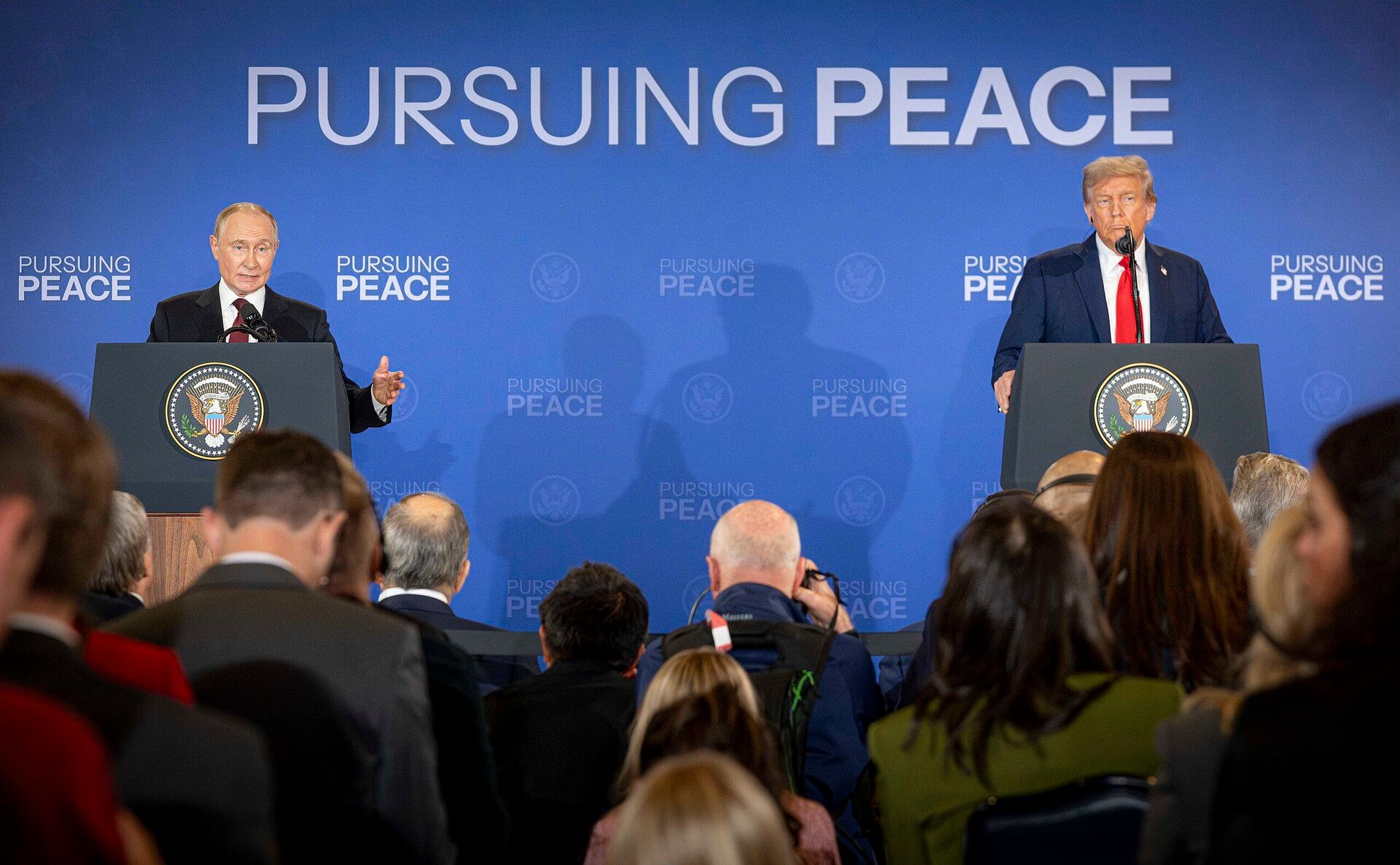DEAR READER,
We are officially on a break until the end of August, but we felt the need to address the recent meeting between Trump and Putin in Alaska. So, we decided to send this special edition prepared by Adam Reichardt to get you up to speed!
— Giorgi Beroshvili, Editor
EXPERT OPINION
War in Ukraine – towards impasse or peace?

Trump, Putin Press Conference in Alaska
Last Friday’s summit and negotiations between US President Donald Trump and Russian dictator Vladimir Putin in Alaska concluded with little details as to what was discussed and even less on what was agreed upon. After the three-hour meeting, Trump announced that while it was “productive”, there was no deal. The next steps would be reaching out to the Ukrainian president and European partners to discuss the results of the Anchorage meeting.
While the summit itself shocked most of the western world by giving a platform to a murderous war criminal, most analysts agreed that Putin came out on top and already achieved his goal of breaking international isolation and portraying himself as an indispensable actor on the global stage. Furthermore, by getting the “red carpet” treatment, Putin was able to demonstrate (to the horror of many, especially Ukrainians) that western unity against Russia is fragile – and the hard trolling by Sergei Lavrov in his “USSR” t-shirt demonstrated Russian confidence in this regard.
In the end, the August 15th meeting confirmed that Trump is not only willing to listen to Putin but also ready to bend to his narrative, granting Putin the upper hand in shaping the agenda around the peace process.
Over the weekend, more details emerged, which have now set the stage for today’s (Monday August 18th) meeting between Trump and Ukrainian president Volodymyr Zelenskyy, who has arrived in Washington with many European leaders in tow. The question now is whether Zelenskyy is willing to succumb to US pressure and accept the “offer” Putin and his delegation outlined in Alaska. From the weekend reports, it appears that the Kremlin is demanding full control over the Donetsk and Luhansk regions and freezing the front lines in the Zaporizhzhia and Kherson regions. This appears to be somewhat of a concession, as we know that previous demands included Russian control over all four regions, despite Russia not occupying large chunks of those territories. It is also important to note that while Russia does occupy almost all of Luhansk, there are still key areas in Donetsk –including the cities of Kramatorsk and Sloviansk – that Ukraine still fully controls.
Putin also demands that the “root causes” of the war are addressed, without providing any details on what this means. Likely he is referring, at minimum, to a change of power in Kyiv, no NATO membership for Ukraine and policies which ensure mechanisms that could allow for future Russian meddling and manipulation in the country (such as language policy).
Interestingly, in exchange, it appears Putin is willing to allow western security guarantees, which could include US-backed assurances and maybe even European troops on the ground. But ultimately, it is more than certain that Putin is not interested in long-term peace. The Russian military needs time to rebuild its capacities, which the Ukrainian army has heroically diminished. However, a strategic pause would be the perfect outcome for Moscow: allowing Russia to consolidate occupied territories, entrench itself politically, and prepare for a renewed offensive when conditions are more favourable.
What happens next?
On Monday August 18th Zelenskyy will meet with Trump in the White House to discuss the “offers”. We already know that Zelenskyy has rejected any plan that requires Ukraine to give up territories, especially those which Kyiv still controls. Zelenskyy will also not accept vague “root cause” conditions that amount to surrendering Ukraine’s sovereignty. For him, the war is existential: to compromise is not to save Ukraine, but to erase it.
For Trump, however, the calculations are different. He sees an opportunity to tout himself as a “peacemaker” even if the peace is nothing more than a thinly veiled capitulation. Europe, meanwhile, will be in Washington with Zelenskyy, watching nervously. It is clear for most EU states that any US-backed settlement which rewards Russian aggression would undermine European security. It would also set a precedent that borders in Europe can be once again changed by force.
Impasse or peace?
The stark reality is that there is no shortcut to peace. Any deal which would force Ukraine to concede territory and sovereignty will not end the war, but will only temporarily freeze it. Putin will also feel emboldened by this victory, escaping any accountability for the countless war crimes conducted during this military invasion and allow him to focus on preparing for the next military campaign.
Zelenskyy, on the other hand, will likely reject the Alaska offer and provide a European-backed counter-offer for Trump to consider and take back to Putin. This would include an immediate ceasefire and freezing of the frontlines at the current positions in order to set the stage for full peace negotiations - certainly an unacceptable path for the Kremlin. Trump, who has also hinted at achieving peace, not just a ceasefire, may also react negatively to Zelenskyy’s offer. In the end it could mean Trump – and the US – abandoning efforts around Ukraine (including security assistance) and the war continuing, which Russia is capable of managing, especially without the threat of new sanctions coming from Washington.
In the end, the world is left to wonder whether Friday’s Alaska summit has brought us closer to peace, or simply deeper into impasse and attrition.
— Adam Reichardt, Editor in Chief at New Eastern Europe
GOT THOUGHTS? WE WANT TO HEAR THEM
It only takes 2–3 minutes to fill out the form, and we genuinely love reading every single response. Share your feedback!
